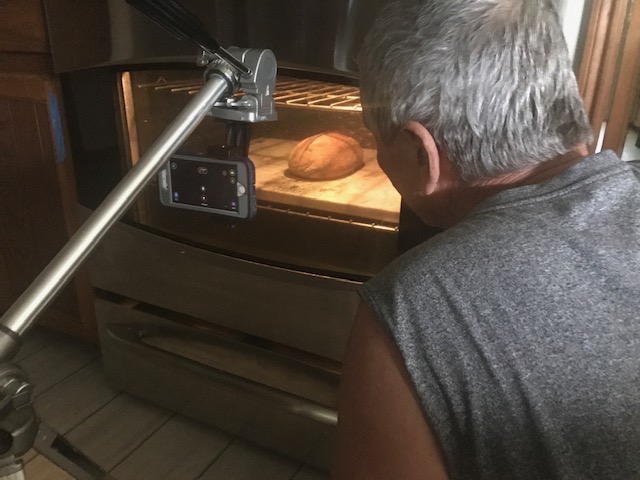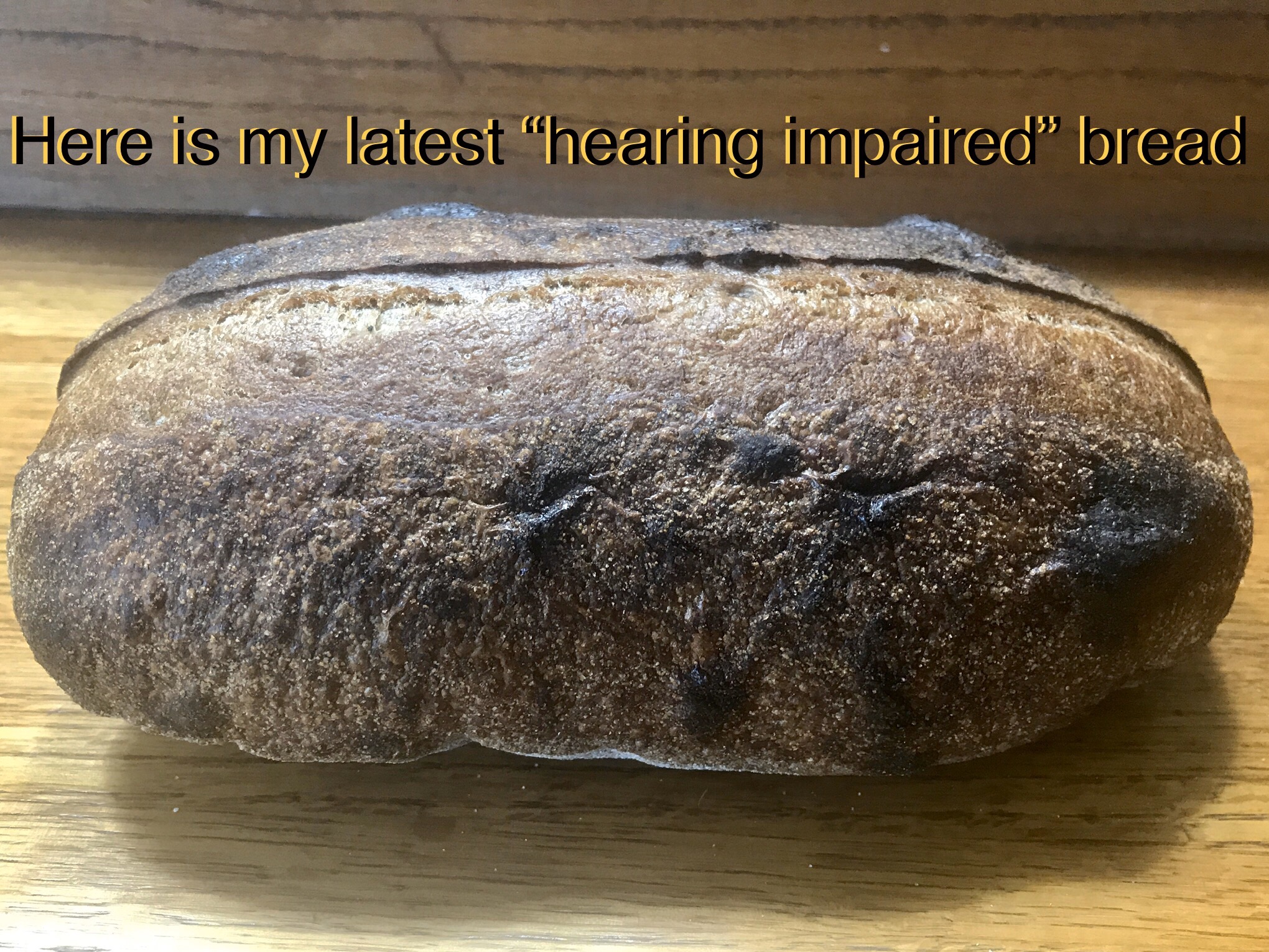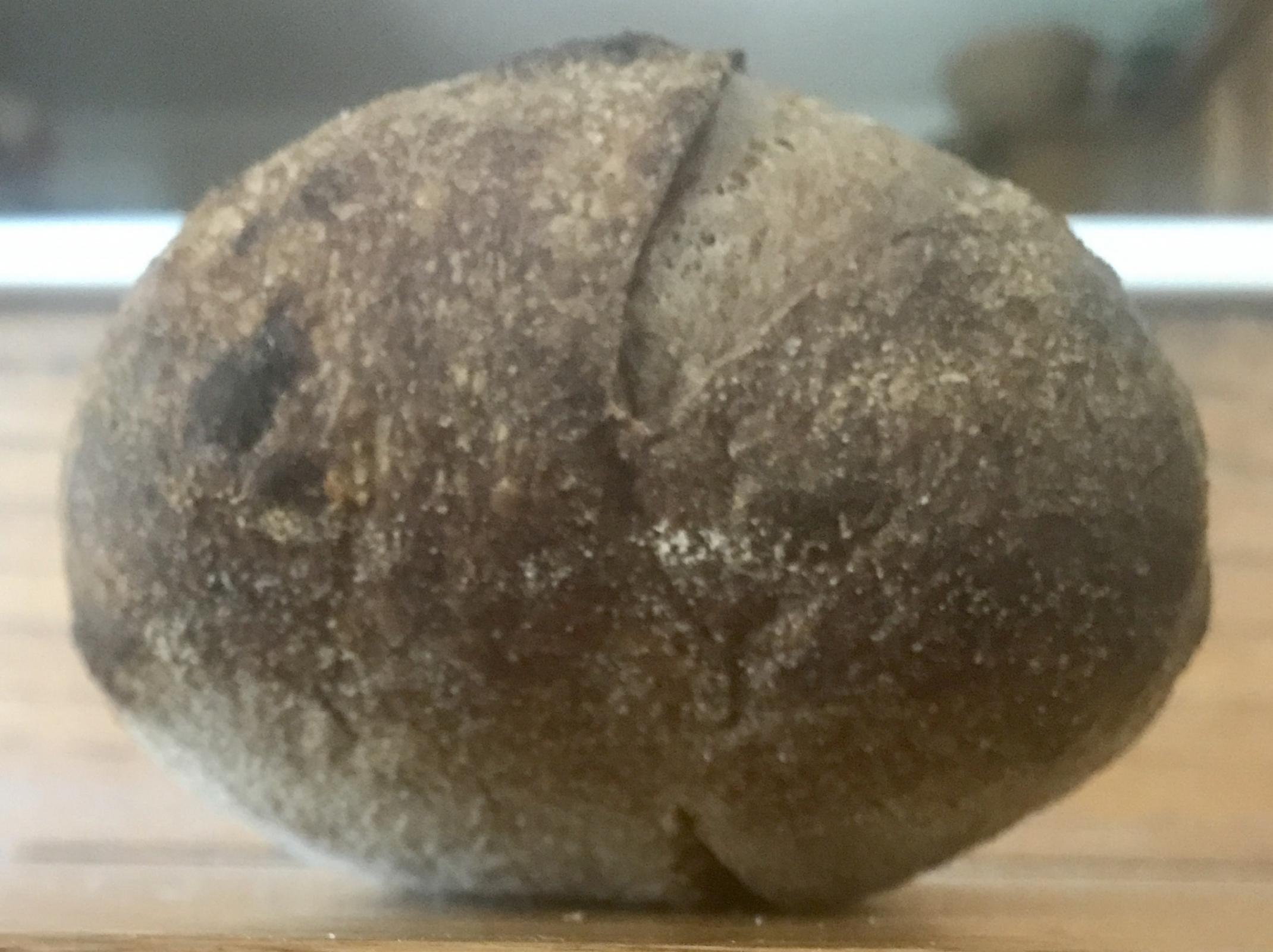After many years of work, my breads are starting to produces ears. BUT, with doughs of hydrations at or over 77%, the plague persist. I know it is possible because the Instagram bakers produce them all the time. Kristen of FullProofBaking is presently featured in our Community Bake and she considers 80% hydration the lower end of her scale for breads with ~20% whole wheat. My thinking, "if they can do it, so can I".
A little history...
- Baked with externally injected steam and also a cast iron combo cooker - same results.
- Baked at very hot temps, 500-550°F in an oven preheated for at least 1 1/2 hours.
- Always baked on the very thick baking stone.
- Attempted with many bakes and various flours.
- Scoring seems adequate, because ears are fairly consistently produce with doughs of lower hydration.
- It seems the gluten and gluten skin is developed enough because the oven spring is great.
It seems the crux of the matter is the dough refuses to fracture at the score line. I've scored at all angles and various depths. Something is missing from the equation, and for the life of me I can't figure this one out!
It would be great, if my dough would break early in the bake like Doc’s dough in this video.
I appreciate any and all help.
Danny
In the video it looks like browning has started before the bloom had a chance to develop and burst through. When I remove the cover after 20 minutes the ear and bloom have completed but there is very little browning. I would try the normal 450 to see if that changes anything.
My other thought is that it is gluten development is more difficult to achieve with wetter dough. Perhaps you should hold back some water to add in at the end of the mixing.
A crumb shot of that loaf might reveal more of the story.
Thanks MT! I’m going to slice the loaf now so a crumb shot can be posted.
NOTE - the dark color on both the crust and crumb are largely due to 2% chocolate malt (N/D). I also did more Coil Folds (5) and more aggressive Coil Folds because I was trying to produce a HoneyComb cell structure.
Surprising to me it looks over proofed, but I thought the BF was terminated prematurely. There were no large bubbles and when viewing from the bottom of the clear container, very little bubble formation was visible. It retarded overnight and my fridge runs 38F.
I retard the dough for 15 hours, which is fairly common for me. But maybe this is too long for wet dough.
Danny
It doesn't look over proofed to me and the amount of oven spring would also say it wasn't. Your crumb would open greatly if it wasn't constrained by the outside hardening off. You can see the cells near the crust have been compressed with the bloom being stopped with nowhere to go.
Once again my two cents worth
Very astute MT! Great catch. I wondered why the crumb was so dense at the edges. I thought maybe it was because the wet and fragile dough was resting upside down in the banneton.
So, to make sure I understand. The crust cooked too fast. It hardened and because of that, it was unable to expand as the gas inflated. That caused the dense crumb around the perimeter and overall tight crumb. Also because the crust hardened prematurely, it was unable to fracture, bloom, and spring open in order to produce the ear.
Please correct any misconceptions...
Thanks for the observation!
Danny
Update - Doc.dough tells me that steam causes the crust to bake faster. Maybe I threw too much steam at the dough. I am capable of injecting huge amounts of steam.
Yes, I am saying that but I was not aware that too much steam could also harden the crust. Steam is only necessary at the very beginning and I believe that commercial ovens only inject it for a few seconds. After seven minutes, as I recall reading somewhere, steam is no longer needed or wanted so that the crust can dry out and get crispy.
Maybe it's a case of too much of a good thing.
My typical method these days is a stone near the bottom. After a one hour preheat at 450 or 475 I cover the loaf with a graniteware roasting pan that was not preheated but the inside is rinsed with water before placing over the loaf. Lately I have been placing a couple of ice cube on the stone next to the loaf before covering for twenty minutes.
I did the community bake loaves at 500 because I did not see the part about reducing the temp after the oven is loaded. I have never been very good at following directions
I hope your next bake will produce the results your after and the riddle will be solved.
Is that a full sized oven tray on the bottom of the oven covered with a sheet of baking parchment? Is that the baking setup being used?
Mini, I think what you are referring to is a couple of silicone mats that stay in the bottom of the oven to make cleaning easier. They really work great and last me about a year.Take a look at them.
Here I am on “Oven Watch”.

Danny
I know how it feels! This happens to me with some of my loaves - and I have two big tips that seemed to work for me...
1. Cut your bulk or proof just a bit to lessen your overall fermentation. This could be as little as 30 minutes which can have a big effect on the ear.
2. You say you are baking at 550degF. This is very hot. As someone else mentioned, your dough is browning super fast - look at it after only about 5 minutes! Note that when I bake using this method, my dough stays basically white until the spring is mostly complete: see video here! When I bake uncovered with a lot of steam, I first preheat the stone and lava rocks for at least 60 minutes at 500degF - the stone is at the lowest possible level in the oven, as far away from the heating element as possible. Note that the fan/convection is off. Just before I load the slashed dough, I turn the oven down to 485degF. Then, work quickly -- I open the door, slide in the dough, pour on the rocks 1 cup hot (boiling) water, and as fast as I can, close the door to trap the steam. Your injection oven will be easier :) I bake for 20 minutes like this... and really I can tell in the first 5-8 minutes if there's going to be an ear or not. It either breaks and tears back and away, or it will just puff up like a balloon. The more the heating element is on, the more chance my dough will harden and crust over.
Another tip - if you have room for it, try placing a second stone ABOVE the dough in the oven to block the direct heat from the heat element. This can help give your dough some buffer from hardening over.
My biggest take away is the possibility that I have been over heating the dough too much initially. It would be great to find out that my long lasting nightmare had such a simple solution...
Thanks for the critique. I welcome the thoughts of others also.
Danny
OH! Here’s my latest hearing impaired bread.


Notice the second image on the right. This type of rise is not uncommon. Notice how small the base is and how thebottom rose up off the stone. Too Much Heat?
The small base is also from the slash sealing up by either too much heat or not enough steam and the loaf then blowing up like a balloon. Doing a shorter proof is a good suggestion to try if lowering the heat doesn't work.
is also my guess but bear in mind that I bake in a Rofco B20. I pre-heat at 260C to really get the stones hot and then directly after loading turn the oven off and can go as low as 150C as the stones retain the heat so well. Some bakers go even down to 100C. If I forget to turn the oven down then I get a glazed over loaf like yours and basically the top cooks too fast and oven spring does not have enough time to happen.
I saw on IG some interesting posts on too much steam in a deck oven and try to find - but again I think too much steam was leading to glazed over loaves if my memory serves me right and in my Rofco I find this even more the case the wetter the dough but need to experiment more on this. My two pennies....Kat
I wonder if the higher hydration doughs are giving me trouble and not the lower ones because of the additional moisture in the dough. So, the water vapor is leaving the dough and the steam is surrounding it. That might make sense, since steam cooks things faster.
Doc tells me (if I understand this correctly) that steam is used to cook faster as the temperature transfer is more efficient with steam.
Danny
There is a chapter in this book by Alan Scott that describes what happens to bread after it is put in a hearth oven that we try to simulate with vessels and stones with steam or what have you in a home oven. If you can find the book it is well worth it.
I think you will find that even lower hydration loaves will improve with the proper baking regimen.
How did you develop the dough before the bulk rise?
Mini, this has been a consistent problem with high hydration. Many breads were mixed using mixers, methods like Kristen’s Basic Open Crumb SD. I think the gluten is well developed because in many cases I use the lamination technique. In order to stretch the dough so thin it seems the gluten is highly developed.
Do you think too much heat could be the cause? It seems if the crust cooks too quickly the it would stiffen and not allow further stretching. Am I on the right track?
If this is solved I’ll be one happy baker.
Dan
or 500°F to 550°F. yup, that's pretty darn hot! I don't think I've ever baked that high. Pizza, yes but not loaves. Are you also using a fan?
hey, try this... make a layered strip of alu foil about 3 layers thick and 2" wide. Loosely cover the length of the score and pop the bread into the oven. Might have to tuck the foil ends under the loaf ends to keep them in place. See if the foil keeps the heat off the score long enough to open it and keep it open.
Something else you could try is just to do your shaping like you normally do and then dust the loaf lightly with rye flour or dust the banneton with rye flour. Go for only a short stint in the banneton with high hydration dough.
The convection fan is never turned on during the first 15 minutes of the bake.
I plan to mix 1 or 2 doughs tomorrow using Kristen’s CB formula for the BOCSD. I am going to go with at least 78%, maybe even 80% hydration. Start the bake at 450F and reduce the steam.
Question - is it plausible that high hydrations doughs, since they have lots of water, require less heat than doughs of more modest hydration? Example - 80% hydration - start bake @ 450F / 68% hydration - start bake @ 500F.
I will be jumping for joy if this problem is resolved.
Danny
Did you get any better results? I think you can still preheat at a high temp just turn it down after loading the oven.
Good luck
On the road again with limited anything but maybe a review of this 80% almost all AP will shed some light...
http://www.thefreshloaf.com/node/49567/no-competitions-me
I’m not a high-hydration kinda dude, other than ciabatta type dough, but this was just for the fun of it.
And >500dF is a mistake in my book. I don’t have issues with lengthy periods of steam.
Alan
Alan,I posted to your Blog here.
Danny,
I suspect that you are seeing the results of the outer layers of the dough cooling off quickly when you put it in the refrigerator and thus severely slowing the fermentation and bubble consolidation processes, while the center of the loaf was warm quite a bit longer and thus fermented more completely and the foam dynamics are different at even modestly elevated temperatures. When you stick it in the oven, the steam condenses on the surface and both gelatinizes and cooks the surface starch. Once the surface temperature exceeds the temperature at which the steam will condense (the local dew point in the oven) there is no additional value to steam. So the seven minute rule is probably a good one for many cases. Also since the outside layers of the dough cook more rapidly than the core, there is again a difference in temperature exposure over the baking time between the outside and the inside of the loaf.
Two things I have previously written may be of value or interest here (or not):
Home oven heat transfer
Debunking a wives tale about steam
High temperatures are for small diameter loaves
Otherwise the crumb in the center is cooked before the surface is browned.
For loaves larger than a couple of inches in diameter you can use more modest temperature and get the result you want.
However, there are bakers who go for a very dark crust color (Lodge Bread in Culver City CA is one) and execute it to get the dark top, but in the process can under-cook the center and produce a very sticky crumb.
Doc you wrote, “ Also since the outside layers of the dough cook more rapidly than the core, there is again a difference in temperature exposure over the baking time between the outside and the inside of the loaf.” and also, “You can use more modest temperatures and get the results you want”.
With that said, do you agree that the crust of my high hydration loaves are cooking (setting up) too fast, thus prematurely hardening and making further expansion (oven spring and ear) impossible?
I reread your articles in the 2 links you referenced above, once again. I noticed something new this time, or I noticed it before and forgot. The non-steamed bread was pale and the steamed bread was very brown, indicating to me that the crust had hardened. The light also turned on about steam NOT facilitating stretch. My ideas and preconceived notions may have had me focused in the wrong direction.
With this in mind
Danny
Learning is often a struggle, but I find the process enjoyable. It helps that I am naturally tenacious. It’s all about the excitement of overcoming...
Danny - It may take a few trials, but you can find the right baking temperature by doing a binary search.
Start with the oven at 500°F and put one of your temperature probes in the middle of the loaf then bake it until the sensor reports 200°F (don't worry, it will overshoot by a few degrees). Stop and record the time and take a picture so that you can compare how brown the crust is.
Now repeat with the oven at 350°F (I expect that it will be lighter in color and take a little longer to reach 200°F in the center.
Now repeat at 425°F (half way between 500°F and 350°F), then at half way between 425°F and whichever bound you want to move toward. If 425°F is too dark, try 387°F, if 425°F is too light, try 462°F.
Keep working your way through the tree until you find the temperature that produces the color you want and 200°F in the middle of the loaf.
In the absence of an in-oven dew-point monitor, you can write your own rule for how long to steam. My baguettes steam for 10min out of 20 min cycle that starts at 505°F, drops to ~390°F over 2 minutes, then comes back to 460°F for 8 min, then 400°F for 10 min with no steam. I think 5-7 min for you is enough.
Have you tried playing with the angle of the score? It looks to me to be not shallow enough. Also, are you using a razor/lame? Are you baking straight from the refrigerator (this can help score without it deflating so much)?